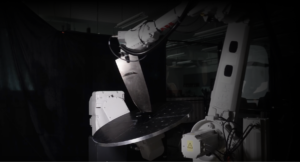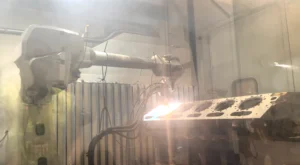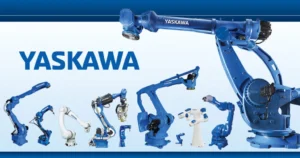table of contents
- Heading 1
- Heading 1
- Heading 1
- What Is a Robot Programming Language?
- What Is the Best Programming Language for Robotics?
- Top 5 Robotic Programming Languages
- Examples of Industrial Robot Languages
- Which Robot Programming Language Should I Learn First?
- Augmentus: The Solution for Fragmented Robot Ecosystem
- Is Augmentus Compatible With Major Robot OEMs?
- Schedule a Demo With Augmentus
- Conclusion
- FAQs
share this
In the dynamic field of industrial automation, robust and simple robot programming solutions are increasingly important. This article aims to clarify the unique programming requirements of significant robot original equipment manufacturers (OEMs), including FANUC, ABB, and Kuka.
What Is a Robot Programming Language?
Robot programming languages are specific languages used to write scripts that directly control robot operations. These include ABB’s RAPID, Kuka’s KRL, URScript for Universal Robots, and Yaskawa’s INFORM, among others. These languages allow you to type sequences that determine how the robots should act and behave during tasks. Unlike conventional programming languages, these are explicitly developed for controlling robots in real time. You can script for motion control, sensory feedback, and hardware interfacing.
What Is the Best Programming Language for Robotics?
In robotics, conventional programming languages like Python, C++, C#, Java, and MATLAB form the foundation for development and simulation. Python and C++ are favored for their integration with the Robot Operating System (ROS), facilitating experimentation with new concepts. Conversely, C# and Java excel in simulations and digital environments, as seen in platforms like Augmentus.
For robot-specific programming, each manufacturer dictates the use of proprietary languages such as ABB’s RAPID or KUKA’s Kuka Robot Language (KRL). These languages help optimize the capabilities of their robots, offering specific solutions but with limited flexibility
So, choosing the best programming language for robotics is challenging. It really depends on the type of project or the type of robots involved and the level of difficulty required. Some of the most powerful and multi-purpose programming languages used in robotics are:
1. Python
Even though there are many good languages, Python turns out to be the most popular choice. It is widely used in robotics for scripting and developing algorithms. It is backed up with a powerful feature of integrating with other tools and software like the Robot Operating System (ROS).
2. C++
C++ is considered the best in situations where the program needs to run very fast and with no delay. It offers a strong environment for addressing the tasks that require direct interaction with the hardware and low-level memory management. C++ is also very popular for ROS as it provides faster performance than Python. A lot of developers start with Python for testing and then move to C++ for its speed.
3. Java
Java is also appreciated in the robotics world for its portability and extensive library. This is important for more complicated, network-enabled, or AI-based robotic systems. Java is well suited for cross-platform programming because any machine that is compatible with the Java Virtual Machine can run Java code.
Top 5 Robotic Programming Languages
Here are the top five robot programming languages that have significantly influenced robotics, offering unique advantages depending on the application:
Python
Python is considered one of the most user-friendly languages that is relatively easy to understand. It minimizes the rate of learning of new programmers while at the same time increasing the rate of development by other programmers. In the field of robotics, Python is indispensable given it has very rich libraries. Some libraries for Python are well-suited for robotic applications. For example, we have NumPy for numerical processing SciPy for scientific computing, and for interacting with the Robot Operating System, there is ROSPy. Furthermore, TensorFlow and PyTorch frameworks enable developers to incorporate advanced AI capabilities into robots using Python. These numerous and varied applications make Python an important and versatile language both in commercial robotics and robotic research.
C++
C++ is highly important in today’s programming environment in situations where the speed of a program is very important. This language provides the highest degree of control over the system resources and interfacing with the hardware since it is a low-level language. In the case of real-time applications with narrow response times and extremely high execution speeds such as automated production lines or drones, C++ enables programmers to optimize each element of the system. Moreover, C++ is also widely used in the creation of the basic frameworks and libraries in most robotic systems. It is suitable for robotic applications that involve complex computations and memory management because of its reliability and precision.
Java
Java’s platform independence makes it well-suited for networked or distributed robotic systems where software portability between different hardware is required. Java applications can be used on any platform that supports JVM. To manage heterogeneous robot networks or integrate systems across various operating environments, JVM is essential. Also, Java provides inherent security features and effective handling of errors. It makes it safe for developers to work on applications that may encounter several operational conditions and cyber threats.
JavaScript
The role of JavaScript has been increasing with robotic systems getting integrated with the web and IoT devices. JavaScript is used to create UI for robot operation control panels and for interacting with web services. It provides an event-driven model. This is good for working with sensor data or any asynchronous tasks in the robot‘s workflow. JavaScript libraries like Johnny-Five have introduced the language to more Linux-based IoT and robotics enthusiasts. As a result, it is particularly suitable for prototyping projects and hosting them on a variety of web platforms.
MATLAB
MATLAB is used in environments like robotic navigation systems or wherever a complex simulation is needed. In such situations, MATLAB is mostly used since it entails mathematical modeling and data analysis. MATLAB has many capabilities and toolboxes incorporated in it for designing control systems. It can quickly process and visualize large quantities of data. Since data from the real world can be transformed into actionable knowledge rapidly, MATLAB is an excellent companion for researchers and students.
All of the above languages play a specific role in the design and control of robotic systems. They offer a wide variety of features that the engineers and developers can use to expand the capabilities of the robots.
Examples of Industrial Robot Languages
Effective robot programming is essential for the accomplishment of automation initiatives. Three prominent companies in the industrial robotics space are FANUC, ABB, and Kuka, each with a distinct robot coding language and approach. Understanding and becoming proficient in the complexities of programming these robots is essential for their smooth integration into a variety of manufacturing processes. This information is important for more than just operating; it affects output, minimizes downtime, and guarantees peak performance.
FANUC
One of FANUC robotic systems’ programming notable strengths lies in its comprehensive range of proprietary option packages, encompassing both hardware and software such as 2D/3D vision (iRVision), force control, and dispensing (DispensePRO). This feature significantly reduces integration and troubleshooting time.
Furthermore, FANUC distinguishes itself by offering a broad payload capacity for its robots, boasting one of the highest in the market at 2.3 tons for industrial robots and 50kg for collaborative robots.
If you are an advanced user seeking more than what the default TP program provides, FANUC offers the option to leverage KAREL. While KAREL is mainly utilized for data computing and socket/serial communication, its motion control capabilities are not as well-developed compared to the TP program. Experienced programmers may encounter challenges with KAREL due to its low-level nature.
ABB
ABB’s robotic systems are known for their versatility and provide a programming environment that emphasizes the value of adaptability. ABB RobotStudio, ABB’s simulation software, is essential in this field because it gives programmers a virtual platform to model and verify robotic processes. This proactive strategy makes it possible to recognize and address possible problems before implementation, resulting in a more seamless and error-free transfer to real-world scenarios.
In terms of ABB robotics programming software, RAPID — ABB’s proprietary programming language, takes center stage. RAPID acts as a high-level interface that makes it easy for programmers to create complex robot programs. Understanding the syntax, commands, and data types of RAPID is essential for anyone hoping to realize the full potential of ABB robots.
Kuka
Kuka robots, renowned for their accuracy, require sophisticated programming. This calls for a thorough grasp of motion control concepts, KRL (Kuka Robot Language), and the use of sophisticated capabilities like force control. Users explore the complexities of Kuka robot programming by working with KRL, a syntax-heavy language, where expertise is essential to realizing the robot’s potential.
Motion control becomes critical while working with Kuka programming. Motion concepts such as joint and Cartesian motion need to be understood to coordinate smooth movements, and the coordination of several axes is necessary to carry out complex tasks. Kuka differentiates itself with its array of functional programming add-ons. For instance, Kuka provides specialized software packages for high precision force control. These allow developers to implement applications requiring a delicate touch or force sensitivity. Understanding these packages is crucial for deploying Kuka robots in specialized tasks. This knowledge makes sure programmers can come up with the right solutions to meet specific industrial needs.
Which Robot Programming Language Should I Learn First?
For beginners in robotic programming, Python can be learned as an initial step. Its straightforward syntax and support through libraries make it an accessible entry point. This foundational knowledge is crucial for understanding basic robotics concepts, which prepares learners for more advanced programming challenges.
Augmentus: The Solution for Fragmented Robot Ecosystem
Augmentus is an AI robotics system created by its founders to transform industrial automation. Their experiences and difficulties inspired them to create robotics solutions. Augmentus’ primary goal is to simplify traditional robot programming so that customers can fully automate industrial robots without having to write a lot of code.
Traditional robot programming presents challenges in fragmentation and costliness. Manufacturers use proprietary languages, demanding extensive training for users. This leads to 75% of lifetime costs attributed to software and programming.
Augmentus revolutionizes this landscape by serving as the sensory and cognitive engine for industrial robots. Utilizing 3D cameras, Augmentus captures spatial data, feeding it into its AI model. The platform then recommends optimal robot paths, accounting for complex surfaces. This eliminates the need for specialized skills and reduces downtime during robotic reprogramming. Augmentus streamlines process automation, slashing the average time from four weeks to just 15 minutes. This remarkable efficiency boost not only enhances accuracy but also reduces costs by over 70%, making Augmentus a transformative solution for manufacturers.
Is Augmentus Compatible With Major Robot OEMs?
One common misconception in the realm of robotics is that automation solutions are exclusive to specific robot brands. Augmentus dispels this misconception by providing compatibility with significant robot OEMs like FANUC, ABB, and Kuka. This ensures that customers, utilizing any robot brand, can seamlessly integrate Augmentus into their current robotic infrastructure.
Augmentus shows its versatility by offering a single platform for programming several robot brands. Due to this flexibility, manufacturers can achieve consistency in automation projects, speed up training, and standardize their programming processes. Augmentus serves as the unifying factor that connects various robotic systems, facilitating communication and user-friendliness.
Schedule a Demo With Augmentus
Scheduling a demo with Augmentus is a simple process that provides access to a revolutionary industrial automation experience. You can find customized alternatives to meet your specific manufacturing requirements. Make sure the demo fits your industry, robot kinds, and unique issues by completing a short request form. Select ac omfortable time slot, get an instant confirmation, and be ready for anengaging online session.
During the demo, Augmentus experts guide you through the capabilities and real-world applications of our AI-driven automation system. This interactive experience allows you to engage, ask questions, and explore how Augmentus can address your industrial challenges. By the end of the session, you’ll have a firsthand understanding of how Augmentus reshapes the future of robot programming, reducing downtime, enhancing efficiency, and propelling your manufacturing processes into a new era of innovation.
Conclusion
In the fast-paced world of industrial automation, the significance of efficient robot programming cannot be overstated. FANUC, ABB, and Kuka have been at the forefront of this revolution, but the missing link often lies in the form of Augmentus – a robotics programming software designed to simplify, accelerate, and optimize the entire process. As we look toward the future of manufacturing, embracing Augmentus is not just a choice; it’s a strategic move towards a more streamlined, efficient, and intelligent era of industrial automation. Schedule a demo today and witness the transformation firsthand. The future of robot programming is now, and Augmentus is leading the way. Schedule a demo and speak with an automation expert today.
FAQs
Is Python or C# better for robotics?
Python is the popular choice for robotics due to its simplicity, extensive libraries, and integration with ROS, making it ideal for rapid development and testing. C# excels in simulations and digital environments.
What is the best robotics programming language for beginners?
Choosing the best programming language for robotics is challenging. It really depends on the type of project or the type of robots involved and the level of difficulty required. In robotics, conventional programming languages like Python, C++, C#, Java, and MATLAB form the foundation for development and simulation. Each comes with their own advantages and limitations.



